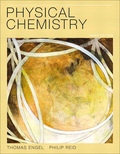
EBK PHYSICAL CHEMISTRY
3rd Edition
ISBN: 9780133556094
Author: Reid
Publisher: YUZU
expand_more
expand_more
format_list_bulleted
Question
Chapter 4, Problem 4.18CP
Interpretation Introduction
Interpretation:
The chemical equation to explain the process of panting by dogs to cool off the hot whether needs to be explained. The value of change in standard enthalpy of reaction needs to be determined.
Concept Introduction :
A
Expert Solution & Answer
Want to see the full answer?
Check out a sample textbook solution
Students have asked these similar questions
What are the missing intermediates 1, 2, and 3? Please include a detailed explanation explaining the steps of malonic ester synthesis. Please include drawings of the intermediates and how they occur.
The following intermediates are to proceed by acetoacetic ester synthesis. What are intermediates 1 and 2 plus the final product 3? Please include a detailed explanation and drawings of the intermediates and how they occurred.
The chemical formula of "benzimidazole E" is C7H6N2. Draw it.
Chapter 4 Solutions
EBK PHYSICAL CHEMISTRY
Ch. 4 - Prob. 4.1CPCh. 4 - Prob. 4.2CPCh. 4 - Prob. 4.3CPCh. 4 - Prob. 4.4CPCh. 4 - Prob. 4.5CPCh. 4 - Prob. 4.6CPCh. 4 - Prob. 4.7CPCh. 4 - Prob. 4.8CPCh. 4 - Prob. 4.9CPCh. 4 - Prob. 4.10CP
Ch. 4 - Prob. 4.11CPCh. 4 - Prob. 4.12CPCh. 4 - Prob. 4.13CPCh. 4 - Prob. 4.14CPCh. 4 - Prob. 4.15CPCh. 4 - Prob. 4.16CPCh. 4 - Prob. 4.17CPCh. 4 - Prob. 4.18CPCh. 4 - Prob. 4.19CPCh. 4 - Prob. 4.20CPCh. 4 - Prob. 4.1NPCh. 4 - Prob. 4.2NPCh. 4 - Prob. 4.3NPCh. 4 - Prob. 4.4NPCh. 4 - Prob. 4.5NPCh. 4 - Prob. 4.6NPCh. 4 - Prob. 4.7NPCh. 4 - Prob. 4.8NPCh. 4 - Prob. 4.9NPCh. 4 - Prob. 4.10NPCh. 4 - Prob. 4.11NPCh. 4 - Prob. 4.12NPCh. 4 - Prob. 4.13NPCh. 4 - Prob. 4.14NPCh. 4 - Prob. 4.15NPCh. 4 - Prob. 4.16NPCh. 4 - Prob. 4.17NPCh. 4 - Prob. 4.18NPCh. 4 - Prob. 4.19NPCh. 4 - Prob. 4.20NPCh. 4 - Prob. 4.21NPCh. 4 - Prob. 4.22NPCh. 4 - Prob. 4.23NPCh. 4 - Prob. 4.24NPCh. 4 - Prob. 4.25NPCh. 4 - Prob. 4.26NPCh. 4 - Prob. 4.27NPCh. 4 - Prob. 4.28NPCh. 4 - Prob. 4.29NPCh. 4 - Prob. 4.30NPCh. 4 - Prob. 4.31NPCh. 4 - Prob. 4.32NPCh. 4 - Prob. 4.33NPCh. 4 - Prob. 4.34NPCh. 4 - Prob. 4.35NP
Knowledge Booster
Similar questions
- Briefly comment (without formulas) on the steps of the aldol condensation mechanism in acidic and basic media.arrow_forwardThe following intermediates are to proceed by acetoacetic ester synthesis. What are intermediates 1 and 2 plus the final product 3? Please include a detailed explanation and drawings of the intermediates and how they occurred.arrow_forwardWhat are the missing intermediates 1, 2, and 3? Please include a detailed explanation explaining the steps of malonic ester synthesis. Please include drawings of the intermediates and how they occur.arrow_forward
- What is the reactant that makes the following product of the reaction? Please provide a detailed explanation and a drawing to show how the reaction proceeds.arrow_forwardDraw the products formed when each ester is hydrolyzed with water and sulfuric acid.arrow_forwardDraw the complete structural formula from each condensed structure. include all hydrogen atoms.arrow_forward
- Draw the complete structural formula from each condensed structure. Include all hydrogen atoms.arrow_forwardIndicate how H2O2 intervenes in the synthesis of K4[Co2(C2O4)4(OH)2]. Write the reactions.arrow_forwardExplain how, based on physical gas adsorption isotherms, we can determine whether multi-walled C nanotubes are open at their ends. Explain this.arrow_forward
- can somone answer pleasearrow_forwardConstruct a molecular orbital energy-level diagram for BeH2. Sketch the MO pictures (schematic representation) for the HOMO and LUMO of BeH2 [Orbital Potential Energies, H (1s): -13.6 eV; Be (2s): -9.3 eV, Be (2p): -6.0 eV]arrow_forwardIndicate the isomers of the A(H2O)6Cl3 complex. State the type of isomerism they exhibit and explain it briefly.arrow_forward
arrow_back_ios
SEE MORE QUESTIONS
arrow_forward_ios
Recommended textbooks for you
 ChemistryChemistryISBN:9781305957404Author:Steven S. Zumdahl, Susan A. Zumdahl, Donald J. DeCostePublisher:Cengage Learning
ChemistryChemistryISBN:9781305957404Author:Steven S. Zumdahl, Susan A. Zumdahl, Donald J. DeCostePublisher:Cengage Learning ChemistryChemistryISBN:9781259911156Author:Raymond Chang Dr., Jason Overby ProfessorPublisher:McGraw-Hill Education
ChemistryChemistryISBN:9781259911156Author:Raymond Chang Dr., Jason Overby ProfessorPublisher:McGraw-Hill Education Principles of Instrumental AnalysisChemistryISBN:9781305577213Author:Douglas A. Skoog, F. James Holler, Stanley R. CrouchPublisher:Cengage Learning
Principles of Instrumental AnalysisChemistryISBN:9781305577213Author:Douglas A. Skoog, F. James Holler, Stanley R. CrouchPublisher:Cengage Learning Organic ChemistryChemistryISBN:9780078021558Author:Janice Gorzynski Smith Dr.Publisher:McGraw-Hill Education
Organic ChemistryChemistryISBN:9780078021558Author:Janice Gorzynski Smith Dr.Publisher:McGraw-Hill Education Chemistry: Principles and ReactionsChemistryISBN:9781305079373Author:William L. Masterton, Cecile N. HurleyPublisher:Cengage Learning
Chemistry: Principles and ReactionsChemistryISBN:9781305079373Author:William L. Masterton, Cecile N. HurleyPublisher:Cengage Learning Elementary Principles of Chemical Processes, Bind...ChemistryISBN:9781118431221Author:Richard M. Felder, Ronald W. Rousseau, Lisa G. BullardPublisher:WILEY
Elementary Principles of Chemical Processes, Bind...ChemistryISBN:9781118431221Author:Richard M. Felder, Ronald W. Rousseau, Lisa G. BullardPublisher:WILEY

Chemistry
Chemistry
ISBN:9781305957404
Author:Steven S. Zumdahl, Susan A. Zumdahl, Donald J. DeCoste
Publisher:Cengage Learning

Chemistry
Chemistry
ISBN:9781259911156
Author:Raymond Chang Dr., Jason Overby Professor
Publisher:McGraw-Hill Education

Principles of Instrumental Analysis
Chemistry
ISBN:9781305577213
Author:Douglas A. Skoog, F. James Holler, Stanley R. Crouch
Publisher:Cengage Learning

Organic Chemistry
Chemistry
ISBN:9780078021558
Author:Janice Gorzynski Smith Dr.
Publisher:McGraw-Hill Education

Chemistry: Principles and Reactions
Chemistry
ISBN:9781305079373
Author:William L. Masterton, Cecile N. Hurley
Publisher:Cengage Learning

Elementary Principles of Chemical Processes, Bind...
Chemistry
ISBN:9781118431221
Author:Richard M. Felder, Ronald W. Rousseau, Lisa G. Bullard
Publisher:WILEY